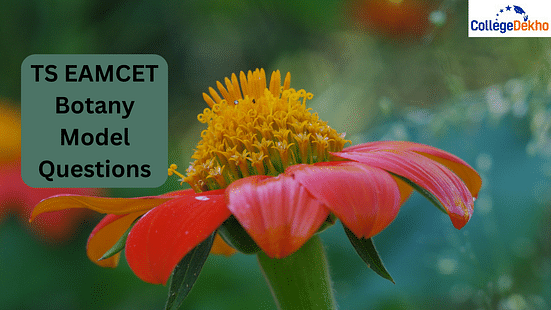Biology is one of the most important sections in the TS EAMCET entrance exam, and Botany questions carry about 25% weightage. Here are some model questions for TS EAMCET Botany to practice for the exam.

Wondering how to crack the TS EAMCET exam ? Is it just completing the whole syllabus or is it something more than this? Our advice is to complete the syllabus as required and put in extra effort to make it to the top 100 students in the rank list. What is that extra thing or effort? Practice, practice, and practice!
So, here we have provided you with the best botany model questions for TS EAMCET Agriculture exam with answers and explanations to help you analyse the answers as well. This list of TS EAMCET botany model questions are some of the frequently asked questions based on past year trends. You can check this article to find out the most crucial questions from topics that are important from the point of view of the exam.
Also Read:
TS EAMCET Model Questions of Botany
Check out the model questions along with their correct answers and explanations from the table below.
Questions | Options | Correct Answer | Explanation |
|---|---|---|---|
Which of the following is a C4 plant? |
A) Wheat
B) Rice C) Maize D) Sunflower | Maize | |
Transpiration is least in which condition? |
A) Windy day
B) Humid day C) Sunny day D) Dry day | Humid day | |
Which of the following is a non-cellulosic polysaccharide found in plant cell walls? |
A) Cellulose
B) Hemicellulose C) Pectin D) Lignin | Pectin | Pectin is a non-cellulosic polysaccharide found in the middle lamella of plant cell walls, important for cell adhesion. |
Double fertilization is found in |
A) Algae
B) Gymnosperms C) Bryophytes D) Angiosperms | Angiosperms | |
The movement of water through a semipermeable membrane is known as: |
A) Diffusion
B) Active transport C) Osmosis D) Plasmolysis | Osmosis | Osmosis is the movement of water from a region of lower solute concentration to higher solute concentration through a semipermeable membrane. |
Which plant hormone is known as the “stress hormone”? |
A) Auxin
B) Gibberellin C) Cytokinin D) Abscisic acid | Abscisic acid | Abscisic acid (ABA) is called the stress hormone as it helps plants respond to stress conditions like drought by closing stomata. |
What is the main photosynthetic pigment in higher plants? |
A) Chlorophyll a
B) Chlorophyll b C) Xanthophyll D) Carotene | Chlorophyll a | |
Which one of the following is a correct pair of homologous structures? |
A. Wings of bird and wings of butterfly
B. Flippers of penguin and fins of fish C. Forelimbs of frog and wings of bird D. Thorns of Bougainvillea and tendrils of cucumber | Forelimbs of frog and wings of bird | Homologous structures have the same anatomical structure but different functions. Both forelimbs of frog and wings of bird have the same basic bone structure but different uses. |
The operon concept was first proposed by: |
A) Watson and Crick
B) Jacob and Monod C) Beadle and Tatum D) Hershey and Chase | Jacob and Monod | |
In a dicot stem, vascular bundles are: |
A. Scattered
B. Arranged in a ring C. Conjoint and scattered D. Radial | Arranged in a ring | In dicot stems, vascular bundles are organized in a circular pattern, which allows for secondary growth. |
Which of the following processes does not occur in photosynthesis? |
A) Photolysis of water
B) Release of O₂ C) Fixation of CO₂ D) Oxidation of glucose | Oxidation of glucose | |
Which of the following tissues in plants is dead at maturity? |
A. Parenchyma
B. Collenchyma C. Xylem vessels D. Phloem | Xylem vessels | Xylem vessels are lignified and dead at maturity to allow efficient water conduction. |
In which part of the plant does guttation occur? |
A) Stomata
B) Hydathodes C) Lenticels D) Cuticle | Hydathodes | |
C4 plants differ from C3 plants in having: |
A) CAM pathway
B) Photorespiration C) Kranz anatomy D) Calvin cycle | Kranz anatomy | C4 plants have Kranz anatomy where bundle sheath cells play a key role in minimizing photorespiration. |
Which of the following is a nitrogen-fixing cyanobacterium found in the coralloid roots of Cycas? |
A) Nostoc
B) Anabaena C) Azolla D) Rhizobium | Nostoc | Nostoc is a cyanobacterium that fixes atmospheric nitrogen in the coralloid roots of Cycas. |
The enzyme that helps in nitrogen fixation is: |
A) Nitrogenase
B) Nitrate reductase C) Nitrite reductase D) Transaminase | Nitrogenase | |
The primary function of the root cap is to: |
A. Absorb water
B. Absorb minerals C. Protect the root tip D. Store food | Protect the root tip | The root cap protects the delicate apical meristem as the root pushes through soil. |
Which part of the embryo gives rise to the shoot system? |
A) Radicle
B) Cotyledon C) Hypocotyl D) Plumule | Plumule | |
The process of double fertilization was discovered by: |
A) Mendel
B) Strasburger C) Nawaschin D) Hooker | Nawaschin | Double fertilization was discovered by Nawaschin in angiosperms, where one sperm fuses with the egg and the other with the polar nuclei. |
In which of the following does meiosis occur? |
A) Leaf cell
B) Root cell C) Microspore mother cell D) Zygote | Microspore mother cell | Microspore mother cells undergo meiosis to form haploid microspores (pollen grains). |
Which of the following is not a part of the embryo sac in angiosperms? |
A. Antipodals
B. Synergids C. Endosperm D. Egg cell | Endosperm | Endosperm is formed after fertilization; it is not part of the embryo sac initially, which includes the egg, synergids, antipodals, and central cell. |
The enzyme Rubisco is associated with: |
A) Glycolysis
B) Photosystem I C) Calvin cycle D) Photorespiration only | Calvin cycle | Rubisco (RuBP carboxylase/oxygenase) catalyzes the fixation of CO₂ in the Calvin cycle |
Which of the following tissues is involved in the transport of water in plants? |
A) Phloem
B) Collenchyma C) Xylem D) Parenchyma | Xylem | Xylem conducts water and minerals from the roots to other parts of the plant. |
Which of the following is a modified stem? |
A. Tuber of potato
B. Leaf of onion C. Tendril of pea D. Root of carrot | Tuber of potato | The potato tuber is a modified stem used for storage and vegetative propagation, evident by the presence of "eyes." |
The process of fusion of male and female gametes is known as: |
A. Pollination
B. Fertilization C. Germination D. Parthenogenesis | Fertilization | Fertilization is the process where the male and female gametes fuse to form a zygote. |
Which of the following is a vestigial structure in flowers? |
A) Ovule
B) Petal C) Staminode D) Sepal | Staminode | A staminode is a sterile or non-functional stamen, considered vestigial. |
Which of these hormones is responsible for cell elongation? |
A) Cytokinin
B) Gibberellin C) Auxin D) Abscisic acid | Auxin | |
Which mineral is essential for the synthesis of auxin in plants? |
A) Magnesium
B) Zinc C) Copper D) Iron | Zinc | Zinc plays a crucial role in the synthesis of the plant hormone auxin (IAA) |
Which of the following is not a characteristic of dicot seeds? |
A) Two cotyledons
B) Endospermic seed C) Reticulate venation D) Presence of tap root system | Endospermic seed | Most dicot seeds are non-endospermic, meaning the endosperm is absorbed during seed development. |
Which of the following is not a product of light reaction of photosynthesis? |
A. ATP
B. NADPH C. O₂ D. Glucose | Glucose | Glucose is synthesized in the Calvin cycle (dark reaction), not in the light reaction. Light reaction produces ATP, NADPH, and O₂. |
Botany Topic Wise Weightage for TS EAMCET Exam
You can check the chapter-wise weightage for Botany here from the table below.
Chapter | Expected Weightage |
|---|---|
Diversity in the Living World | 1-2 |
Structural Organisation in Plants - Morphology | 0-1 |
Reproduction in Plants | 4-5 |
Plant Systematics | 2-3 |
Cell Structure and Function | 2-3 |
Internal Organisation of Plants | 1-2 |
Plant Ecology | 0-1 |
Plant Physiology | 5-6 |
Microbiology | 2-3 |
Genetics | 3-4 |
Molecular Biology | 2-3 |
Biotechnology | 1-2 |
Plants, Microbes and Human Welfare | 1-2 |
Also Read: TS EAMCET Zoology Model Questions
Important Topics from Botany for TS EAMCET Exam
Check the chapter-wise important topics for the Botany paper here.
Topics | Important Topics |
|---|---|
Diversity in the Living World |
|
Structural Organisation in Plants - Morphology |
|
Reproduction in Plants |
|
Plant Systematics |
|
Cell Structure and Function |
|
Internal Organisation of Plants |
|
Plant Ecology |
|
Plant Physiology |
|
Microbiology |
|
Genetics |
|
Molecular Biology |
|
Biotechnology |
|
Plants, Microbes and Human Welfare |
|
With the help of the TS EAMCET Botany Model Questions, you can strategise your preparation in the right direction. Solving the model questions will assist you in contemplating the important topics from Botany and also aid in boosting your confidence level.
Also Read:
Get personalised guidance from our experts by dialling our toll-free number 1800-572-9877. You can also post your queries regarding the TS EAMCET exam on our QnA zone .
Are you feeling lost and unsure about what career path to take after completing 12th standard?
Say goodbye to confusion and hello to a bright future!

FAQs
From the botany section of the TS EAMCET exam, you must focus on topics like plant physiology, genetics, reproduction in plants, microbiology, and molecular biology to name a few.
No, the TS EAMCET exam is not at all a tough exam. With proper guidance and focus on your studies, you can easily clear the exam.
Was this article helpful?



















Similar Articles
AP EAPCET 2026 Agriculture Syllabus: Subject-wise, Syllabus PDF Download
AP EAPCET (EAMCET) Agriculture 2025: Response Sheet (Out), Answer Key (Released), Objections (May 27 to 29), Result (June 14), Counselling
Tamil Nadu BSc Agriculture (TNAU) Admission: Application Forms (OUT), Last Date (Jun 8), Eligibility, Ranking Process, Counselling
Bihar Agriculture Admissions (BCECE) 2025: Dates (OUT), Application Form (closed), Admit Card (OUT), Results, Counseling
Uttar Pradesh BSc Agriculture Admission: UG Exam on Jun 11, Admit Card (OUT), Results, Counselling
Tripura BSc Agriculture Admission: Dates, Application Process, Eligibility, Top Colleges, Counselling